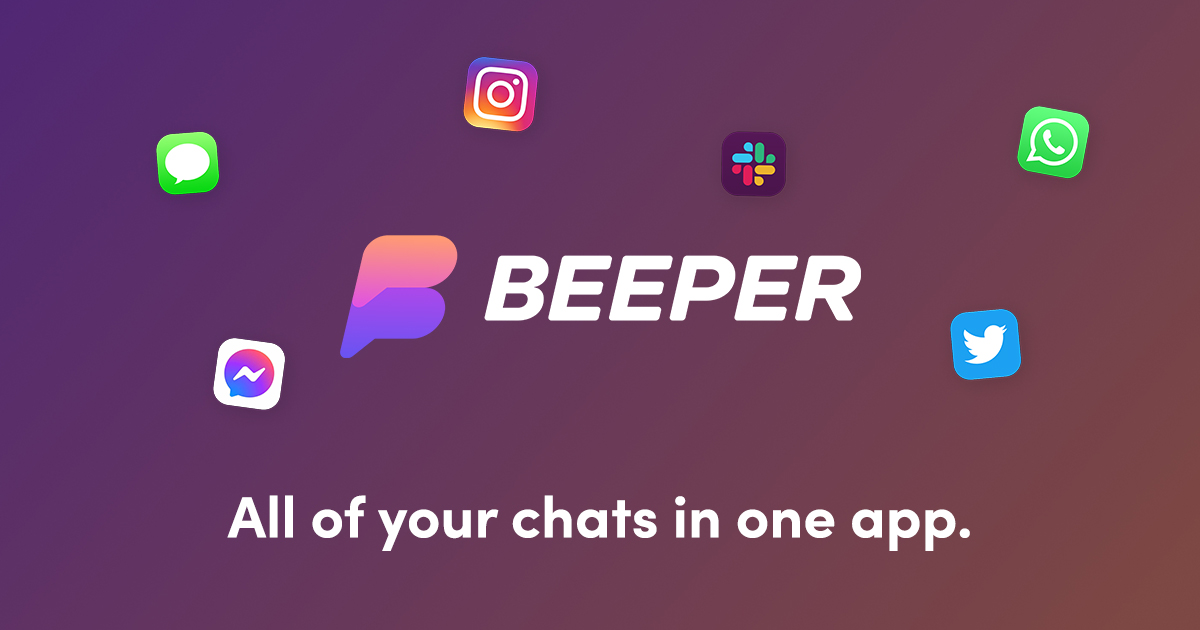Beeper, The killer chat app
Beeper is a secure, all-in-one chat app, and hopefully the last chat app you'll ever need. Image © Automattic Inc.
Contents
Note: I am unaffiliated with Beeper, Automattic, or any other organizations mentioned in this post.
Introduction ⚓
Discord. Facebook Messenger. Slack. Matrix. Telegram. SMS. RCS.
I talk to people in a dozen different ways using a dozen different tools. Normally, this meant having a bunch of apps installed on my phone, all of them doing the same thing in a slightly different way: sending messages to people.
And for a while, this worked. I booted my laptop, opened FacelacktrixcordgramMS, and went about my business. When I was out and about, I did a little relay race through my app drawer to see who was posting what and where.
But now, I don’t need to. Just one app, and I can see all my messages from everywhere in one spot. On my phone, and on my laptop.
It’s called Beeper 🔗. I try not to shill commercial products, but this is seriously a game-changer. Beeper is both an app and a service that consolidates messages from a bunch of different popular chat apps into one place. In addition to all the ones I listed, it also works with IRC, Signal, Twitter, Google Chat, Instagram, and LinkedIn. It’s free to use, free to download, and has apps for pretty much every platform.
“What’s the catch,” you ask? Honestly, I can’t find one. The website says it’s free to use, with an optional paid subscription Coming Soon™️, but there aren’t any gates in the current product or service. It’s owned by Automattic, the same company behind WordPress, but as far as I can tell it’s not run by venture capitals or big investors. So for now at least, there is no catch that I can see.
How does Beeper work? ⚓
Beeper is a chat aggregator: it goes out, fetches messages from various services, and brings them all into one spot, beeper.com. On the backend, it’s all powered by Matrix 🔗, an open source encrypted messaging protocol that puts privacy and security above all else (yes, even convenience).
Matrix is built in a way that prevents anyone from reading your messages except for you and the people you’re messaging. It works for direct messages, but amazingly, it also works for group chats and calls.
What Beeper does is pretty ingenious. It hosts a bunch of bridges 🔗 that connect Beeper to all of these apps. You create your Beeper account, then log into each service through Beeper. Beeper then pulls the messages, encrypts them with a Matrix key that only you have access to, and stores them. That “only you have access to” is very important, because if you lose that key, that’s it. Nobody can access those messages again, not even Beeper. Granted, they’ll still be on the original service (Beeper just makes copies), but the journey from FacelacktrixcordgramMS to your eyeballs is completely opaque to the outside world.
Better still, Beeper is 100% compatible with Matrix. The Beeper app is just a modified version of Element 🔗, one of the most popular Matrix apps. You can use any Matrix-compatible app you want. The one I’m using is SchildiChat 🔗. You just log into the app, verify it through the Beeper app, and you’re done. It’ll immediately start pulling and decrypting your messages and bring you right where you left off. It’s literally easier than setting up some regular chat apps.

Where Beeper and Matrix fall short ⚓
Of course, it’s not all sunshine, roses, and magic. Since Matrix is its own protocol and relies on bridges, all the other services must be translated into the lowest common denominator. This means certain features, like custom emojis in Discord or custom stickers in Telegram, just don’t work. Or if they do, setting them up isn’t straightforward. I also haven’t tried video or audio calls, so I can’t speak to their reliability or even whether the functionality exists.
Also, the encryption/decryption process sometimes fails. This leads to the infamous Unable to decrypt message error that plagues Matrix users to the point where
the primary guide has an entire page dedicated to it 🔗. Normally it just takes a few minutes for messages to sync between your devices, but other times it can leave entire conversations unreadable. It’s just something to be prepared for, in case it catches you off-guard.
Even more confusingly, not all Matrix clients work the same way. Element is kinda the de facto standard, and the bases that many (most?) other clients are built on, including Beeper. That doesn’t make it perfect though, and many of its bugs and imperfections made their way into these other apps. The Beeper app is fine, but if you want to play around and try some different ones, I recommend checking out Element 🔗, SchildiChat 🔗, and FluffyChat 🔗.
Still though, I highly, highly recommend giving Beeper a shot if you’re like me, and you’re tired of dancing between a dozen chat apps.
Final thoughts on Beeper ⚓
The good:
- Really easy to get started with.
- Supports most major chat networks.
- Handles Discord rooms, group chats, and similarly organized chats pretty effortlessly.
- Built on top of the existing Matrix ecosystem, including the ability to use different Matrix clients and host your own server.
The bad:
- Doesn’t completely replace your chat apps.
- Doesn’t support app-specific features.
- Brings all the baggage of Matrix, yet isn’t fully integrated with Matrix.
The ugly:
- No obvious path to revenue. How does Automattic plan to make money off this? They won’t keep hosting a free service out of the goodness of their hearts.
| Previous: "The Antidepressant That Changed My Life" | Next: "Why is enabling automatic updates in NixOS so hard?" |

